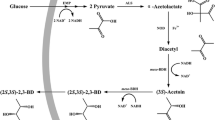Abstract
A biosynthetic pathway for the production of (S)-3-hydroxybutyric acid (S3HB) from glucose was established in recombinant Escherichia coli by introducing the β-ketothiolase gene from Ralstonia eutropha H16, the (S)-3-hydroxybutyryl-CoA dehydrogenase gene from R. eutropha H16, or Clostridium acetobutylicum ATCC824, and the 3-hydroxyisobutyryl-CoA hydrolase gene from Bacillus cereus ATCC14579. Artificial operon consisting of these genes was constructed and was expressed in E. coli BL21 (DE3) codon plus under T7 promoter by isopropyl β-d-thiogalactoside (IPTG) induction. Recombinant E. coli BL21 (DE3) codon plus expressing the β-ketothiolase gene, the (S)-3-hydroxybutyryl-CoA dehydrogenase gene, and the 3-hydroxyisobutyryl-CoA hydrolase gene could synthesize enantiomerically pure S3HB to the concentration of 0.61 g l−1 from 20 g l−1 of glucose in Luria–Bertani medium. Fed-batch cultures of recombinant E. coli BL21 (DE3) codon plus were carried out to achieve higher titer of S3HB with varying induction time and glucose concentration during fermentation. Protein expression was induced by addition of 1 mM IPTG when cell concentration reached 10 and 20 g l−1 (OD600 = 30 and 60), respectively. When protein expression was induced at 60 of OD600 and glucose was fed to the concentration of 15 g l−1, 10.3 g l−1 of S3HB was obtained in 38 h with the S3HB productivity of 0.21 g l−1h−1. Lowering glucose concentration to 5 g l−1 and induction of protein expression at 30 of OD600 significantly reduced final S3HB concentration to 3.7 g l−1, which also resulted in the decrease of the S3HB productivity to 0.05 g l−1h−1.



Similar content being viewed by others
References
Chiba T, Nakai T (1987) A new synthetic approach to the carbapenem antibiotic PS-5 from ethyl(S)-3-hydroxybutanoate. Chem Lett 11:2187–2188
Choi J, Lee SY, Han K (1998) Cloning of the Alcaligenes latus polyhydroxyalkanoate biosynthesis genes and use of these genes for the enhanced production of Poly(3-hydroxybutyrate) in Escherichia coli. Appl Environ Microbiol 64:4897–4903
De Roo G, Kellerhals MB, Ren Q, Witholt B, Kessler B (2002) Production of chiral R-3-hydroxyalkanoic acids and R-3-hydroxyalkanoic acid methylesters via hydrolytic degradation of polyhydroxyalkanoate synthesized by pseudomonads. Biotechnol Bioeng 77:717–722
DiRusso CC, Black PN, Weimar JD (1999) Molecular inroads into the regulation and metabolism of fatty acids, lessons from bacteria. Prog Lipid Res 38:129–197
Ferreira T, Simonelli F (1990) Synthesis of two stereoisomers of the propanoate ester of 8-methyl-2-decanol using remote asymmetric induction. Tetrahedron 46:6311–6318
Fishman A, Eroshov M, Dee-Noor SS, van Mil J, Cogan U, Effenberger R (2001) A two-step enzymatic resolution process for large-scale production of (S)- and (R)-ethyl-3-hydroxybutyrate. Biotechnol Bioeng 74:256–263
Gao HJ, Wu Q, Chen GQ (2002) Enhanced production of d-(3)-hydroxybutyric acid by recombinant Escherichia coli. FEMS Microbiol Lett 231:59–65
Haywood GW, Anderson AJ, Chu L, Dawes EA (1988) The role of NADH- and NADPH-linked acetoacetyl-CoA reductases in the poly-3-hydroxybutyrate synthesizing organism Alcaligenes eutrophus. FEMS Microbiol Lett 52:259–264
Hong SH, Lee SY (2001) Metabolic flux analysis for succinic acid production by recombinant Escherichia coli with amplified malic enzyme activity. Biotechnol Bioeng 74:89–95
Hong SH, Park SJ, Moon SY, Park JP, Lee SY (2003) In silico prediction and validation of the importance of Entner–Doudoroff pathway in poly(3-hydroxybutyrate) production by metabolically engineered Escherichia coli. Biotechnol Bioeng 83:854–863
Lee SY, Lee Y (2003) Metabolic engineering of Escherichia coli for production of enantionmerically pure (R)-(−)-3-hydroxycarboxylic acids. Appl Environ Microbiol 69:3421–3426
Lee SY, Lee Y, Wang F (1999) Chiral compounds from bacterial polyesters: sugars to plastics to fine chemicals. Biotechnol Bioeng 65:363–368
Lee Y, Park SH, Lim IT, Han K, Lee SY (2000) Preparation of alkyl (R)-(−)-3-hydroxybutyrate by acidic alchoholysis of poly-(R)-(−)-3-hydroxybutyrate. Enzyme Microbial Technol 27:33–36
Lee SY, Hong SH, Lee SH, Park SJ (2004) Fermentative production of chemicals that can be used for polymer synthesis. Macromol Biosci 4:157–164
Liu Q, Ouyang SH, Chung A, Wu Q, Chen GQ (2007) Microbial production of R-3-hydroxybutyric acid by recombinant E. coli harboring genes of phbA, phbB and tesB. Appl Microbiol Biotechnol 76:811–818
Mori K (1981) A simple synthesis of (S)-(+)-sulcatol, the pheromone of Gnathotrichus tetusus employing baker’s yeast for asymmetric reduction. Tetrahedron 37:1341–1342
Noyori R, Ohkuma T, Kitamaru M (1987) Asymmetric hydrogenation of b-keto carboxylic esters. A practical, purely chemical access to b-hydroxy esters in high enantiomeric purity. J Am Chem Soc 109:5856–5858
Park SJ, Lee SY (2003) Identification and characterization of a new enoyl coenzyme A hydratase involved in biosynthesis of medium-chain-length polyhydroxyalkanoates in recombinant Escherichia coli. J Bacteriol 185:5391–5397
Sambrook J, Russell DW (2001) Molecular cloning: a laboratory manual. Cold Spring Harbor Laboratory press, Cold Spring Harbor, NY, USA
Steinbüchel A, Valentin HE (1995) Diversity of bacterial polyhydroxyalkanoic acids. FEMS Microbiol Lett 128:219–228
Sugai T, Ohta H (1989) Enzymatic preparation of ethyl (S)-3-hydroxybutanoate with high enantiomeric excess. Agric Biol Chem 53:2009–2010
Zhao K, Tian G, Zheng Z, Chem JC, Chen GQ (2003) Production of d-(−)3-hydroxyalkanoic acid by recombinant Escherichia coli. FEMS Microbiol Lett 218:59–64
Zheng Z, Gong Q, Liu T, Deng Y, Chen JC, Chen GQ (2004) Thioesterase II of Escherichia coli plays an important role in 3-hydroxydecanoic acid production. Appl Environ Microbiol 70:3807–3813
Zhou BN, Gopalan AS, Shieh WR, Sih CJ (1983) Sterochemical control of yeast reductions. 1. Asymmetric synthesis of l-carnitine. J Am Chem Soc 105:5925–5926
Acknowledgement
Dr. Soon Ho Hong appreciates the supports from the 2007 Research Fund of University of Ulsan.
Author information
Authors and Affiliations
Corresponding authors
Rights and permissions
About this article
Cite this article
Lee, SH., Park, S.J., Lee, S.Y. et al. Biosynthesis of enantiopure (S)-3-hydroxybutyric acid in metabolically engineered Escherichia coli . Appl Microbiol Biotechnol 79, 633–641 (2008). https://doi.org/10.1007/s00253-008-1473-7
Received:
Revised:
Accepted:
Published:
Issue Date:
DOI: https://doi.org/10.1007/s00253-008-1473-7




